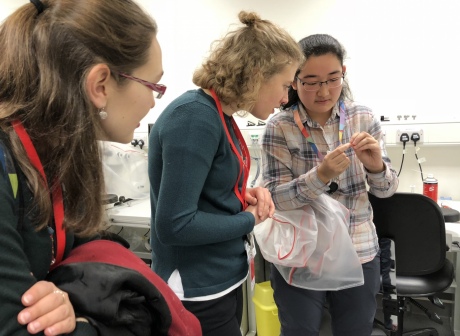
Yuxin with her microscope

Imperial student Yuxin Zhang is spending a year in industry at the Francis Crick Institute. Jess Wade went to find out what she's been up to...
Imperial's BSc in Biological Sciences offers third-year students the opportunity to complete a twelve-month research or industry placement. Life Sciences student, Yuxin Zhang, applied for a position at the Francis Crick Institute; she is now working at the Crick's Electron Microscopy Science and Technology Platform, which is well-equipped with both state-of-art instruments and expertise for life science imaging across scales from single molecules to tissues.
Yuxin is working on a custom-built two-photon light microscope, which allows researchers to image deep inside intact biological tissues, examining the structure and function of cells in their natural environments. What is special is that her microscope can brand specific parts of neuronal tissues that her team is interested in before the sample is imaged by scanning electron microscope for detailed structures.
In a traditional microscope a single photon excites a fluorophore; the difference with the microscope Yuxin is working on is that two-photons of long wavelength infrared light emitted within femtoseconds of each other can combine to excite the fluorophore. This happens so quickly that the fluorophore doesn’t know it’s not one high energy photon, a nonlinear optical process first described in 1931 by Maria Goeppert-Mayer. Low energy light is scattered less and has a deeper penetration depth than high energy single photon excitation.

A microtome room where ultra-thin sections for EM imaging are cut
Yuxin's microscope can mark a region of interest, transfer the sample to a scanning electron microscope and selectively scan the area she is interested in. By targeting where is crucial for slower, more sensitive SEM measurements, Yuxin will massively speed up data collection, as well as opening the door to new in situ measurements.
When Yuxin arrived at the Crick she was given an infrared laser, an optical bench and the help of a few physicists. In less than five months she has taught herself quantum physics, built an incredibly complicated microscope and become an invaluable part of a dynamic group at the Francis Crick Institute.
The longer I spend with Yuxin the easier it is to forget she is an undergraduate student and not a full-time researcher. At high school Yuxin was interested in evolutionary biology, fascinated by how something as simple as a nucleus could evolve into something as complicated as the brain. She's also interested in the development of social structures and philosophy, especially in relation to her research. Yuxin doesn’t just want to image neurons, she wants to explore why we dream, sleep and taste; ultimately she wants to investigate the basis of consciousness.
When’s she’s not building the microscope, Yuxin spends her time reading physics text books. Before she came to the Crick she had no idea that scientists and engineers were working together to build microscopes facilitating the experimental dreams of researchers. And now she wants to keep building. I can’t wait to see where she ends up doing her PhD!

Yuxin and members of the Imperial College Women in Physics student society
Article text (excluding photos or graphics) © Imperial College London.
Photos and graphics subject to third party copyright used with permission or © Imperial College London.
Reporter
Jessica Wade
Department of Materials

Contact details
Email: jessica.wade@imperial.ac.uk
Show all stories by this author



